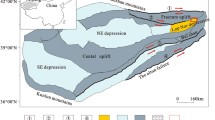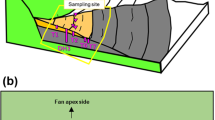Abstract
The potash-bearing deposit was located in the Vientiane Basin of Laos where exists one of eastern Tethys metallogenic belt. The water-insoluble of Thongmang mining area in this basin were selected as carrier, through leaching and analysis, showed the water-insoluble minerals mainly include anhydrite, boracite, hilgardite, carbonate, quartz and muscovite, in which anhydrite, boracite and muscovite were dominant minerals. Mineralogical and morphological analyses of the water-insoluble minerals from different borehole-derived potash mineral strata have elucidated the evolution process of brine salt formation and restore the paleo-potassium deposit environment. The water-insoluble minerals revealed that the sedimentary environment in the late stage of salinity belongs to the shallow water disturbing environment. Accompanied by the fluvial influx and the influence continued, under the strong influence of terrestrial water body in the late salt-forming period, the evolution process of salt-forming brine will inevitably be affected. And the displacement of sedimentary center occurred during the metallogenic stage. Thus, this studies show that the characteristics of the water-insoluble can be used to retrieve the evolution process of brine salt formation and refect environment changes of the paleo-potassium deposits. In a word, the characteristics of water-insoluble minerals can provide effective information indicating the changes of sedimentary environments at the late stage of brine evolution.
















Similar content being viewed by others
References
Fan PF (2000) Accreted terranes and mineral deposits of Indochina. J Asian Earth Sci 18:343–350
Flügel E (2010) Microfacies of carbonate rocks—analysis interpretation and application. Springer, Berlin-Heidelberg, New York
Garrett DE (1996) Potash deposits-processing, properties and uses. Chapman and Hall, London
Grice JD, Gault RA, Velthuizen JV (2005) Borate minerals of the Penobsquis and Millstream Deposits, southern New Brunswick Canada. Can Mineral 43:1469–1487
Hite RJ, Japakasetr T (1979) Potash deposits of Khorat Plateau Thailand Laos. Econ Geol 74:448–458
Li MH, Yan MD, Fang XM, Zhang ZJ, Wang ZHR, Sun SR, Li J, Liu XM (2018) Origins of the Mid-Cretaceous evaporite deposits of the Sakhon Nakhon basin in Laos: evidence from the stable isotopes of halite. J Geochem Explor 184:209–222
Meesook A (2000) Cretaceous environments of northeastern Thailand. In: Okada H, Mateer NJ (eds) Cretaceous environments of Asia. Amsterdam, Elsevier, pp 207–223
Metcalfe I (1996) Gondwanaland dispersion, Asian accretion and evolution of eastern Tethys. Aust J Earth Sci 43(6):605–623
Metcalfe I (2006) Palaeozoic and Mesozoic tectonic evolution and palaeogeography of east Asian crustal fragments: the Korean peninsula in context. Gondwana Res 9(1–2):24–46
Metcalfe I (2011) Tectonic framework and Phanerozoic evolution of Sundaland. Gondwana Res 19:3–21
Metcalfe I (2013) Gondwana dispersion and Asian accretion: tectonic and palaeogeographic evolution of eastern Tethys. J Asian Earth Sci 66:1–33
Qu YH, Yuan PQ, Shuai KY, Zhang Y, Cai KQ, Jia SY, Chen CD (1998) Potash forming rules and prospect of Lower Tertiary in Lanping-Simao basin Yunnan. Geological Publishing House, Beijing, pp 1–118 (in Chinese with English abstract)
Racey A, Goodall JGS (2009) Palynology and stratigraphy of the Mesozoic Khorat Group of NE Thailand. In: Buffetaut E, Cuny G, Le Loeuff J, Suteethorn V (eds) Late Palaeozoic and Mesozoic ecosystems in SE Asia. Geological Society, London Special Publications, pp 67–81
Ren QH, Du YSH, Gao DL, Li BK, Zhang YX, Liu XT, Yong XL (2018) A multi–fluid constrain for the forming of potash deposits in the Savannakhet basin: geochemical evidence from halite. Acta Geologica Sinica (english Edition) 92(2):755–768
Richter DK (1983) Calcareous ooids: asynopsis. In: Peryt TM (ed) Coated grains. Springer, Berlin, pp 71–99
Saminpanya S, Duangkrayom J, Jintasakul P, Hanta R (2014) Petrography, mineralogy and geochemistry of Cretaceous sediment samples from western Khorat Plateau, Thailand, and considerations on their provenance. J Asian Earth Sci 83:13–34
Simone L (1981) Ooids: a review. Earth Sci Rev 16:319–355
El Tabakh M, Schreiber BC, Utha-Aroon C, Coshell L, Warren JK (1998) Diagenetic origin of basal anhydrite in the Cretaceous Maha Sarakham salt: Khorat Plateau NE Thailand. Sedimentology 45:579–594
Tan HB, Ma HZ, Li BK, Zhang XY, Xiao YK (2010) Strontium and boron isotopic constraint on the marine origin of the Khammuane potash deposits in south eastern Laos. Chin Sci Bull 55(3):1–8
Tang QL, Zhang XY, Miao WL, Li YSH (2013) Study of geochemical characteristics of salt deposits during halogeneses in Tongmang mining area, Vientiane Laos. J Salt Lake Res 21(03):10–16
Utha-Aroon C (1993) Continental origin of the Maha Sarakham evaporites, north eastern Thailand. J Southeast Asia Earth Sci 8(1–4):193–203
Zhang XY, Ma HZH, Ma YQ, Tang QL, Yuan XL (2013) Origin of the late Cretaceous potash-bearing evaporates in the Vientiane basin of Laos: δ11B evidence from borates. J Asian Earth Sci 62:812–818
Zhang XY, Cheng HD, Tan HB, Yuan XL, Li YSH, Miao WL, Li TW, Ma HZH (2015) Late Cretaceous potash evaporites in Savannakhet basin of middle Laos: geochemical evidences of non–marine inputs. Acta Petrologica Sinica 31(09):2783–2793 (in Chinese with English abstract)
Acknowledgements
The authors would like to thank all the partner who assisted with analyzing the insoluble minerals. The work in this article is supported by grants from the National Natural Science Foundation of China (41602086) and (42072101).
Author information
Authors and Affiliations
Corresponding author
Additional information
Publisher's Note
Springer Nature remains neutral with regard to jurisdictional claims in published maps and institutional affiliations.
Rights and permissions
About this article
Cite this article
Qi-liang, T., Xi-ying, Z., Wei-liang, M. et al. Mineralogical characteristics and sedimentary envrionment significance of water-insoluble minerals in potash deposits of Vientiane Basin of Laos. Carbonates Evaporites 36, 70 (2021). https://doi.org/10.1007/s13146-021-00734-5
Accepted:
Published:
DOI: https://doi.org/10.1007/s13146-021-00734-5




